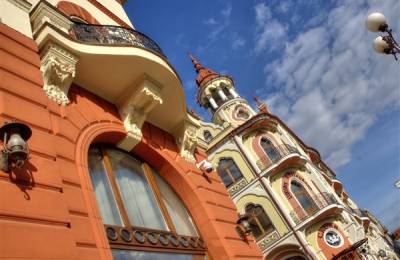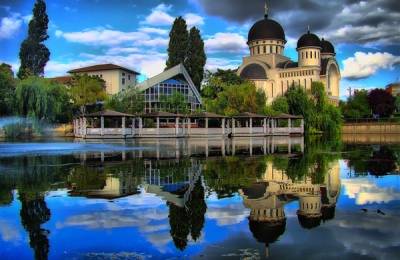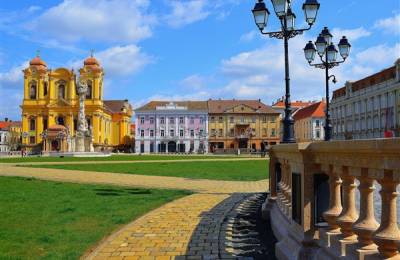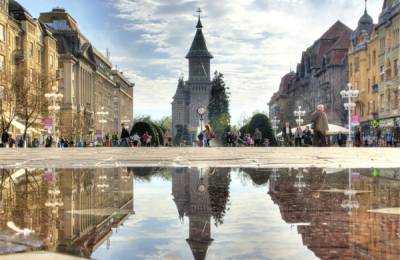Description
The areas of Banat (in the south of the Mures River) and Crisana (to the north) have a lively, spiritual autonomy found nowhere else in Romania, driven by their sense of regional identity, ethnic diversity and tangible Habsburg influence.
The Romanian Banat includes the counties of Timis, Caras-Severin, Arad and Mehedinti, and is only one of the three parts of Banat Region that is situated in Central Europe. The other 2 parts are: the western part in northeastern Serbia (the Serbian Banat, mostly included in Vojvodina, except for a small part included in Belgrade Region) and a small northern part in southeastern Hungary (Csongrad county).
Crisana is bounded in Romania by Maramures in the north, Transylvania in the east, the Banat in the south, and the Hungarian Pannonian Plain in the west. The region consists of the current Romanian counties of Arad (most of it), Bihor and some parts of Sălaj, Satu Mare and Hunedoara.
Oradea, Arad and Timisoara were once large military fortresses marking the southeastern extent of Austria-Hungary, while being culturally and politically married to Yugoslavia’s Vojvodina and Hungary’s Great Plain.
While flaunting three of Romania’s most ‘European’ cities, in both essence and crumbling Habsburg architecture, the regions are also sprinkled with tempting offerings such as the soaring Apuseni Mountains, ski runs, deep caves, gorges, waterfalls and curative thermal waters.
Attractions
Timişoara
Timişoara was the first city in Europe that had electric street lamps (1884) and the second to introduce horse-drawn trams (1867).
Romania’s fourth largest city is known by locals as Primul Oraş Liber (First Free Town), for it was here that anti-Ceauşescu protests first exceeded the Securitate’s capacity for violent suppression, in the 1998 Revolution.
On the other hand, Timişoara is dubbed the ‘city of flowers’ after the ring of pretty parks that surrounds it (Botanical Park, Rose Park, Central Park, Children's Park), and is one of the country’s most developed and multicultural cities, comprising strong Hungarian, German and Serbian minorities.
The main attractions of the city are: The Metropolitan Cathedral, Victory Square or Opera Square - the symbol of the Romanian revolution (here you can find The Metropolitan Orthodox Cathedral, The Opera House, The City Hall, The Philharmonic and The Banat Museum), Union Square - with its beautiful palaces and all the coffee houses it is the old city's center, Liberty Square - a small square with old buildings, The Bastion - part of Timisoara's old defensive walls, The Village Museum, The Museum of the Revolution.
With its charming Mediterranean air, regal Habsburg buildings and a cultural and sporting scene that’s unequalled in Romania, it’s a city that is loved by residents and tourists alike.
Oradea
The capital of Crişana, Oradea lies a few kilometres east of the Hungarian border, at the edge of the Carpathian Mountains. Inhabited since the Bronze Age, the area has been an important commercial, trade and communications point since the 11th century.
In the 18th century, Viennese engineer Franz Anton Hillebrandt planned the city in baroque style, leading to the construction of many contemporary landmarks such as the Roman Catholic Cathedral and the Bishop’s Palace (now the Museum of the Land of the Criş Rivers). The river Crişul Repede runs through the city centre, accentuating the architectural beauty of the area.
The main attractions of the city are: Baroque Cathedral - the biggest baroque cathedral in Romania, Oradea's Fortress, The Moon Church - a church unique in Europe, with a type of astronomical clock depicting the phases of the moon, The "Black Eagle" Passage, The State Theatre, The Main Street - one of the most beautiful streets of Transylvania, displaying an incredible number of Art Nouveau buildings and other 100 religious sites of different denominations in Oradea, including three synagogues and the biggest Baptist church in Eastern Europe.
Arad Fortress
Arad Fortress is one of the most important historical monuments existing in the West Side of the country.
Situated on the banks of the river Mures, the fortress was built between 1762-1783 by Vauban system, according to plans Austrian architect Philip Ferdinand Harsch and was considered to be a very important military building. Built in the form of six-pointed star, the building was provided with three rows of underground pillbox and several rows of ditches. In the complex was a chapel which was built with a fortress. The main gate and inside the buildings were built in Baroque style.
Felix Baths
Felix Baths are located in Bihor County, in northwest of Romania, near the Oradea city, at 9 km distance of Oradea and 22 km of Bors, border checkpoint to Hungary. Felix Bath are situated at 150 m altitude, the climate is moderate, with mild winters.
The settlement, dating since 1711-1721 when here started the first organized establishments for treatment with termal waters, enchants by Natural Reservation with a great number of water lilies, thermal water lilies ( lotus Nymph), a tropical species.
The waters from here contains sulfates, bicarbonate, calcium, sodium and silicon which are very good in the treatment of inflammatory rheumatism, posttraumatic diseases, diseases of the central and peripheral nerve system, gynecological diseases and chronic abdomen inflammations.
In Felix Bath there is an old church, dating from XIV century, with elements of Romanesque architecture and Gothic style, restored in 1977. Also there is a wonderful building, called Sanifarm Building, a former monastery which belonged to St. Vincentiu monastic order, in Baroque style, built in XVIII century.
The baths are the largest balneary resort from Romania, standing on the second place after the Black Sea coast considering the number of accommodation.
Herculane Roman Baths
Băile Herculane, the Herculane Baths, is one of the well-known and beautiful balneo-climatic resorts in Romania and is one of the oldest spa resorts in the world. Situated in the fascinating valley of the Cerna River, the baths are surrounded by forests reservation (protected since 1932), that are housing rare trees, turtles and butterflies.
The thermal and mineral waters of the Herculane Baths were first discovered and exploited by the soldiers of the Roman legions that conquest Dacia since 105 – 107 A.D. The mineral springs from here were named “Thaermae Herculi” and were mentioned for the first time in a document in 153 A.D. The Romans called this area “Ad acquas Herculi Sacras” (the ‘Holy Water of Hercules’), due to the healing properties of the waters and this is were the actual name comes from.
The Roman patricians used to come to the resort, and the waters from here became known all over the Roman Empire. Even Emperor Marcus Aurelius himself came here for treatment! Throughout the years, numerous celebrities stopped at Herculane Baths, including Goethe, Andersen, Emperor Franz I and his wife, the Empress Charlotte, Archiduke Karl, Emperor Franz Josef and his wife, the Empress Sissi.
The thermal and mineral waters of the Herculane Baths were first discovered and exploited by the soldiers of the Roman legions that conquest Dacia since 105 – 107 A.D. The mineral springs from here were named “Thaermae Herculi” and were mentioned for the first time in a document in 153 A.D. The Romans called this area “Ad acquas Herculi Sacras” (the ‘Holy Water of Hercules’), due to the healing properties of the waters and this is were the actual name comes from.
The Roman patricians used to come to the resort, and the waters from here became known all over the Roman Empire. Even Emperor Marcus Aurelius himself came here for treatment! Throughout the years, numerous celebrities stopped at Herculane Baths, including Goethe, Andersen, Emperor Franz I and his wife, the Empress Charlotte, Archiduke Karl, Emperor Franz Josef and his wife, the Empress Sissi.
Diseases successfully treated here include rheumatic, gynecological, peripheral nervous system diseases, and diseases of the digestive system.
Bears Cave
Known as one of the spectacular touristic objectives of Apuseni Mountains, Bears Cave lies in the vicinity of the location called Chiscau, at an altitude of 482 meters.
The name of the cave is due to the numerous bear fossils, which were found there, so therefore it represented a favorable place for shelter for the animals that used to live there 15000 years ago. Owing to the falling of a huge rock, the mouth of the cave was blocked and more than 140 bears were trapped inside. Being hungry, the bears attacked one another until they all died.
The name of the cave is due to the numerous bear fossils, which were found there, so therefore it represented a favorable place for shelter for the animals that used to live there 15000 years ago. Owing to the falling of a huge rock, the mouth of the cave was blocked and more than 140 bears were trapped inside. Being hungry, the bears attacked one another until they all died.
Being more than 1500m long, the cave presents galleries situated on two levels: the upper gallery is 488 meters long and is intended to tourists and the lower gallery (521m in length) is destined to the scientific research.
In this cave there are three galleries and four halls: The Candles Hall, The Spaghetti Hall, Emil Racovita HallandThe Bones Hall.
Semenic National Park – Caraşului Gorge
Within this park lies the widest virgin beech wood forest in Europe (close to 50 km²), with over 350 year old beech woods, mountain elms measuring nearly two meters across, hornbeams, sycamore, ashes, birches, durmasts, junipers and bilberries. The park contains Romania’s largest compact karst structure, and stunning mountain landscapes are set off by beautiful naturally dammed lakes: Secu, Vãliug, Trei Ape. Visitors seek out both water sports and relaxation here.
Botanical and zoological diversity are very rich. Here you can find 1.200 species of plants and 691 species of animals which are strictly protected. The rivers have cut impressive channels through the rock, and underground flows have created 125 hollows and 566 caves.
At 1446m, Semenic Mountain is the highest peak in the country’s South-West, and you also can find ski resorts.
Nerei Gorge National Park
The area’s spectacular landscapes will delight you even before you enter in the park. On the marked hiking trails or cycle-friendly access roads you will be able to admire Turkish hazelnut tree and the superb pinks of Banat iris or peony. You may see also some of the local fauna: white eagle, large martin, red-breasted swallow, cirl bunting, bear, lynx or a horned viper.
The local stone is mainly calcareous, so water has been able to sculpt many caves: Dubova, Gaura Porcarului, Sfânta Elena, Ochiul Beiului, Lacul Diavolului, and rock formations including Gorges of Nera, Miniş and Şuşarei.
Popular visitor destination include Bigãr, Beuşniţa and Şuşara waterfalls and the cultural and historical sites such as Cãlugãra Monastery and Socola Fortress.
During spring and in early summer you can raft on Nera River and try canoeing in the gorges.










